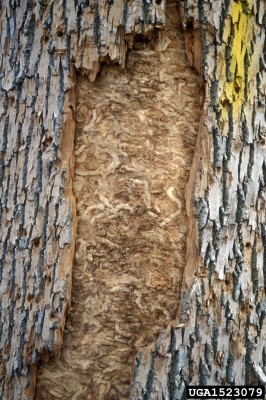By Marcia Myers

Emerald Ash Borer damage – photo by Daniel Herms, The Ohio State University, Bugwood Images
Not surprisingly, officials confirmed that the Emerald Ash Borer (EAB) resides in St. Louis County. Previously, the beetle was found in St. Charles County and the City of St. Louis. As time goes by, the beetles are expected to kill all untreated ash trees in the infested areas.
As you may know, EAB was discovered in Michigan in 2002. Before that, scientists didn’t even know what was killing the trees. The beetle is not a problem in its native East Asian habitat. However, in the United States, EAB’s voracious appetite has killed millions of trees in 27 states. The larvae disrupt the flow of water and nutrients by eating the inner bark and then the tree dies. Unfortunately, people have helped the beetles spread by moving firewood.
A recent article in the New York Times online summarizes two studies trying to understand how East Asian ash trees repel the beetles naturally by using chemicals. Are the North American ash trees (1) not producing high enough levels of chemicals, (2) not using chemicals in the right balance, and/or (3) not making the chemicals fast enough?
In an experiment at the University of British Columbia, a plant hormone prompted North American ash trees to kill off many EABs equivalent to a “lethal dose of insecticide.” This method could be a way to help trees “beef up” their own natural defenses, and perhaps one day the EAB could live in harmony in this ecosystem as in Asia. It’s encouraging, but research so far is inconclusive and ongoing.
In the meantime, MDC recommends that homeowners decide either to replace or save their ash trees. In order to save them, treatment needs to begin in the spring to be effective. For more information about emerald ash borers including photos, videos and symptoms, visit the MDC website. For treatment options, download this PDF.


There are 3 woodpeckers, Downy, Hairy and Red-bellied, along with White-breasted Nuthatches that have been found to eat EAB. The birds may be more effective than chemicals.
http://10000birds.com/emerald-ash-borers-vs-woodpeckers-and-nuthatches.htm
Yeah woodpeckers! The more natural ways to control the EAB the better…
I have had pairs of all four of those birds in the yard this year. I have also noticed that several young ash trees in the yard have died this summer. Thank you for this detailed article. I will ask for some help in identifying what is going on with my trees.
I am glad the article was helpful and that you’re looking into your ash tree problem.